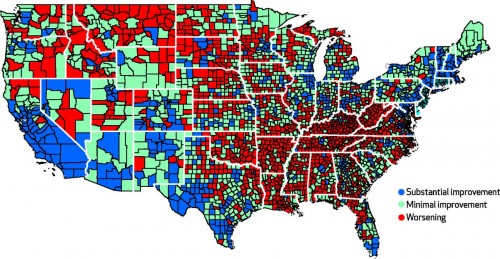The following is a guest post from Bill Gardner, a psychologist who studies the mental health service system for children. Bill is an American living in Canada and a professor of pediatrics at Dalhousie University (Nova Scotia) and the Ohio State University. Bill blogs at Inequalities, and you can follow him on Twitter at @Bill_Gardner.
There is a frightening graph in a recent article in Health Affairs by David Kindig and Erika Cheng. Kindig and Cheng looked at trends in male and female mortality rates from 1992–96 to 2002–06 in 3,140 US counties. What they found was that female mortality rates increased in 42.8% of counties (male mortality rates increased in only 3.4%). The counties are mapped below: red means that female mortality worsened. You can see a strong regional pattern: just about every county showed had worsened female mortality in several southern states, while no county showed such decline in New England. There are many questions about what explains this pattern. For example, did healthier women migrate out of the south from 1992 to 2006? Nevertheless, the map depicts a shocking pattern of female hardship, primarily in the southeast and midwest.
When I look at the graph, however, I am concerned not just about the women, but also about their children. The mental and physical health of mothers is a key determinant in children’s growth and development. What the map shows is that America has regions of communities with high concentrations of women experiencing substantial hardship. When women are not able to maintain their own health, how well can they nurture their children?
This trend is amazing in a historical context. Overall US life expectancy had been increasing steadily over the decades. Before seeing data like these, I had the simple view that increasing life expectancy was part of a general increase in human well-being, powered by the steady growth in economic well-being. In fact, US GDP per capita increased from $24,400 in 1992 to $44,600 in 2006 (in current US $). This is a huge shot for the average American (although it was less for the median American). But a large subgroup of women was apparently left behind. I speculate, but do not have the expertise to test, that what we are seeing is that the widely discussed increase in economic inequality in late 20th century America is also an increase in geographic inequality. My guess is that not only are rich Americans rapidly pulling ahead of poor Americans, but that these groups are also increasingly segregated by region.
It takes a family and a village to raise a child. What happens when the moms in the village all get crushed?



